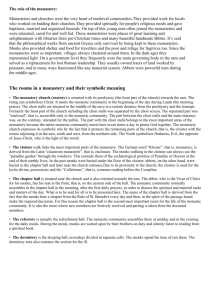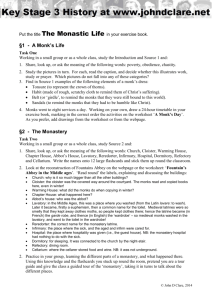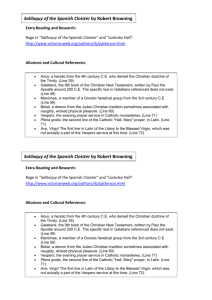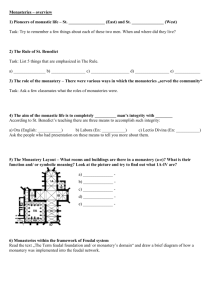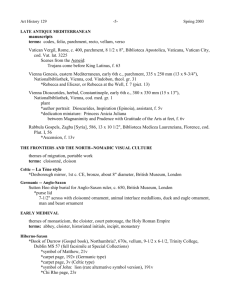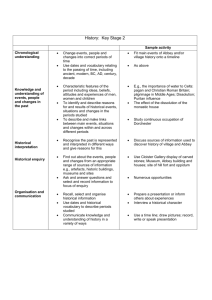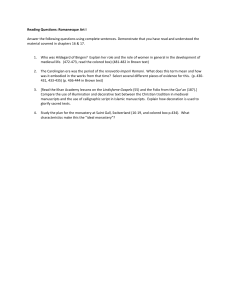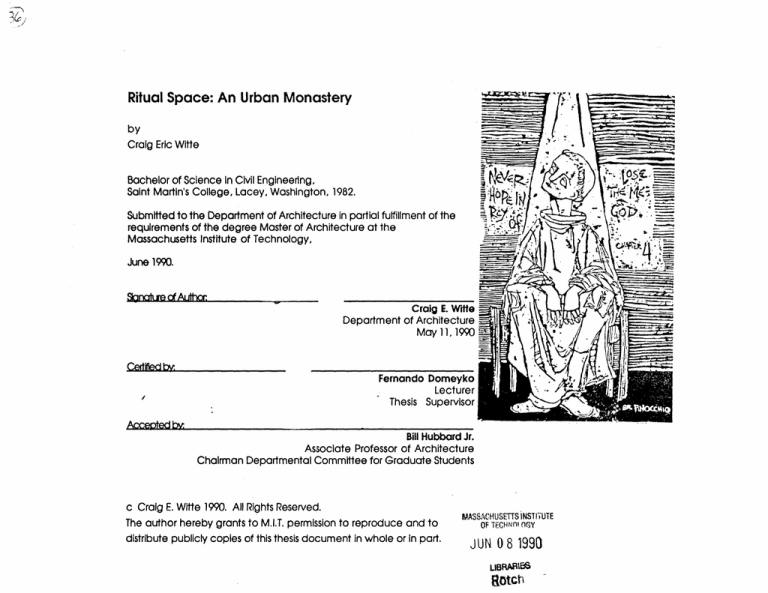
Ritual Space: An Urban Monastery
by
Craig Eric Witte
Bachelor of Science InCivil Engineering,
Saint Martin's College, Lacey, Washington, 1982.
Submitted to the Department of Architecture inpartial fulfillment of the
requirements of the degree Master of Architecture at the
Massachusetts Institute of Technology,
June 1990.
Slanature of Authon.
Craig E.Wite
Department of Architecture
May 11, 1990
Certied bv
Fernando Domeyko
Lecturer
Thesis Supervisor
Bill Hubbard Jr.
Associate Professor of Architecture
Chairman Departmental Committee for Graduate Students
c Craig E.Witte 1990. All Rights Reserved.
The author hereby grants to M.I.T. permission to reproduce and to
distribute publicly copies of this thesis document in whole or in part.
S AC-H
USE-T1S INSiUTE
OF -1ECHN"nl fGY
JUN 0 8 1990
us1RARI
aotch
RITUAL SPACE: AN URBAN MONASTERY
By Craig Witte
Submitted to the Department of
Architecture on May 11, 1990 in partial
fulfillment of the requirements for the degree
of Master of Architecture.
ABSTRACT
This thesis addresses the problem of how to
design an internally consistent world of
religious contemplation and ritual as
insulated from an essentially secular, highly
urban context. The project is a Christian
monastery in Boston's South End loosely
based upon the order of Saint Benedict.
Monastic life, is by nature a utopian
condition. Urban life, in total, is considered
Anti-utopian, potentially destructive to the
contemplative religious existence. The
Monastery has also traditionally existed as a
model community to the larger urban
society. To be an effective exemplar and
a member of the larger community, the
monastery must allow the city access to its
spiritual and physical resources. The goal
-here is to design both the monastic space
and its regions of encounter with the Urban
world. Thus, in addition to the "cloistered"
monastery there isa small church, a primary
school for grades K-3, a hostel and a public
swimming pool.
The book is subdivided into two parts. The
first part deals briefly with monasticism and
ritual, the precedent of monastery types,
and concludes with a commentary on Le
Corbusiers monastery for the Dominicans at
La Tourette. The second part is the design
project which addresses urban and site
issues in a diagramatic form. This isfollowed
by cursory outline of the program and the
building's collective construction systems.
The book finishes with descriptions of the
place as five distinct elements. Symbolic
and physical content is conveyed either
through a narrative framework or as a virtual
listing of the architectural elements and their
essential characteristics.
Advisor: Fernando Domeyko
Title: Lecturer.
3
I would like to thank the many who
have helped me In this endeavor of
self and professional discovery:
Elane for her love, support and
penetrating sense of organization
and timing.
Fernando for the depth and power
of his criticism.
Father George, Father Urban and
Father Sean and the monks of St
Martins Abbey for their insight into the
mystery.
Tom Chastain and Eric Dluhosch:
teachers of uncommon ability.
Peter, Daniel, John, Rich, Laura, Rob,
Shira, Rick, and Al, who helped me
when I needed it most.
To MIT, I am forever in its debt.
The entire thesis crew and especially
my good friend _oe.
My family.
5
Title Pa g e ....................................................................................-.....
---...
--- 1
Ab stract ............................................................................................................
2
Acknowledgements ................................................................................
4
Contents ......................................................................................
...
.. 6
Introduction .............................................................................
20
Monasticism and Monastery Precedent ..........................................
26
The Project: ......................................................................................
..... . . 42
Urban Context: Introduction and Responce
Program and Construction
The Monastery
The Church
The Pool
The School
The Hostel
Bibliography .....................................................................--
142
7
Order is, at one and the same time,
that which isgiven in things as their inner
law, the hidden network that
determines the way they confront one
another, and also that which has no
exsistence except in the grid created
by a glance, an examination, a
language; and it is only in the blank
spaces of this grid that order manifests
itself in depth as though already there,
waiting in silence for the moment of its
expression.
Michel Foucault.
9
The game and the creation of the
game must be seen as one
phenomenon, and indeed, it is
subjectively plausible to say that the
sequence is playable only so long as
it retains some elements of the
creative and unexpected. If the
sequence is totally known then it is
ritual. If play is the establishment and
exploration of relationship then
greeting and ritual are the affirmation
of relationship.
Gregory Bateson.
10
11
What the primitive man does has
been done before, his life is the
ceasless repetition of paradigmatic
gestures initiated by others and given
meaning, reality, solely to the extent to
which those gestures repeat a
primordial act. An object or an act
becomes real only insofar as it imitates
or repeats an archtype. Not only
does ritual reproduce the original act
but in the repetition and participation it
also takes place at the same
mythical, primordial moment. All
sacrifices, all acts of ritual are thus
coincident with the mythical instant of
the innitial act. Through this parodox of
rite profane time and duration are
suspended. History itself is abolished
and the celebrant is transported into
the mythical time and space of the
original event.
Mircea Eliade.
13
The brain has special mechanisms for
coding space in terms of time. For
children the present is highly
subjective, they cannot coordinate
the dual nature of the present, which is
both an objective reference point for
the past and the future and a
category of experience in its own
right. They tend to confuse the
boundaries between past, present
and future. Through play they learn to
mark these boundaries and seperate
their idea of the present from
experience of the present. This is
called decentering and it colls for on
ability to understand various time
relationships from different points of
view In time and space.
Jeremy Cambell.
15
All really inhabited space bears the
notion of home.
A house constitutes a body of images
that give mankind proofs or illusions of
stability....To bring order to these
images I believe we must consider
two principal themes, !) A house is
imagined as a vertical being. It rises
upward and descends downward. It
appeals to our consciousness of
verticallity. 2) A house is imagined as a
concentrated being. It appeals to
our consciousness of centrolity.
Gaston Bachelard.
17
The monasteries gave the human
enterprise the regular collective beat
and rythm of the machine; for the
clock is not merely a means of
keeping track of the cannonical hours,
but of synchronizing the acts of men.
Lewis Mumford.
18
19
I20
C7
WT
-AL;
RO t. -T
Scy~i
21
How to address an issue as
complex and mysterious as ritual
and then design a space to
effectively support Its practice?
Herein is,at least, on articulation of
the problem and an attempt at a
solution. This design isan attempt
to explore the field of human
experience, call on its essence
and house it in physical form. A
modest goal, no less. Guided by
the thoughts of Bateson, Eliade
and the others adumbrated
above, I choose the dualities of
ritual and play, the known and
unknown, and time and mortality
as the designs generating
metaphysic.
The occurance of rite and play in
the every day serves to maintain
an understanding of the unknown
and unknown as complimentary
states of mind. Those states of
mind are accompanied by
comparable states of time space.
If a young child lives in a mythical
time and progresses towards
profane time through the creation
of play, then a monk seeks to
abolish profane time and progress
towards mythical time through the
repetition of ritual.
The knowledge and experience
of our mortality, that is, our
development in the physical world
of common experience, marks
the perceptual boundaries of
profane and mythical time. There
is a vague awareness of this
boundary that eludes investigative
understanding. And yet, this
awareness informs, perhaps
directs, the apprehension of
meaning. It isstrange. Arising from
the mist the question hovers, can
and how do we know that which is
unknowable: God, ourselves or
our place in the scheme of things?
How is meaning and place
restored to the body of the
individual and collective soul?
One answer may lie in the ability to
unask the questions that choke the
faith. Without faith there isno living
rite or play, no creation or
establishment of the potentially
stable new. Perhaps rite and play
are the agents to bond the known
and the unknown as a single unit
and unask the question of
Oedipus.
My project needs to recognize this
presence and discern its
components in order to design its
realization. I will conclude that to
make a space conducive to ritual
it must approximate as closely as
possible
the
continual
maintenance of the known
Interspersed and balanced with
the unknown. Here there are
concerns with the actual qualities
of contemplative and ritual space.
Julie Meservy has observed three
essential elements in the successful
formation of contemplative
space. There is the center, the
reference and the frame. The
center Isthe physical place from
which the contemplative knows his
positon In space and time.
Through the secure inhabitation of
this center, the individual isable to
focus on the reference bef re
him. The reference is a "moble
threshold between inner ond ou er
experience
allowing the
contemplator to transfer his be g
through exstension" to anot er
state of mind.
The fra e
embodies
the
physical
boundaries of the place. It se es
to Isolate the contemplative fo m
external intrusions and offers a
multidimensional place of pea e
and serenity. The notion of
threshold
is crucial for
understanding this project
A threshold is a bound ry
between worlds, physi al
conditions or states of mind. In t e
threshold, for the moment of
transition, two conditions e ist
simultaneously. If the known i a
world or state experienc d
before transition, then in transition to
another world there is passage to
the relatively unknown. The
threshold cradles opposites
together and In the shifting nature
of Its time and space offers the
sight, choice and the possible
recognition and merging of
multiple worlds. It Isa place that Is
at least two places. It isa place of
control and potential. Considering
the design problem, the threshold
ismore than a physical opening, It
Is the quality and scale of the
social and spatial interaction
between worlds.
The monastery interacts with the
secular world through its supporting
functions of the church, hostel,
school and swiming pool. These
functions physically and socially
surround the cloistered life acting
as thresholds.
Each threshold offers a different
quality and scale of society to the
cloistered life. Each function
admits the city to the physical and
spiritual space in different degrees
The
and types of access.
encounter with the city In the
church is different from that in the
hostel, school or swimming pool.
24
25
Monasticism and Monastery
26
27
For the Benedictines and indeed for
all western christian monasticism the
essential collective ritual is in the
Eucharist and the Offices of the Rule.
The Eucharist is one of the seven rites
of the historical christian church
considered to have been instituted or
observed by Jesus as a testament to
inner grace or as a channel that
mediates grace.
Here the last
supper isdaily commemorated in the
act of eating and the celebration of
the Mass. The body and blood of
Christ Is physically embodied in the
bread and wine of every meal.
The Rule of Saint Benedict guides
every individual and collective act of
monastic
life towards the
embodiment of a perfect society. It
is a complete prescription for living.
Eating washing and working are all
invested with symbolic importance in
the divine order of things.
If the rule is the construct for
establishing and maintaining this
"perfect" society, the office of the
rule represents the ritual act of
collective devotion engaged at
precise times during each day. This
originally occurred seven times a day
in response to the biblical caveat
"seven times of day I have rendered
praise to you'. Thus, gathering occurs
to recite psalms. responsories and
prayers through Matins, Lauds, Prime,
Terce, Sext, Vespers and Compline
The offices were rendered so
absolutely that a clock was invented
to maintain the necessary synchronThe monastery
Ized precision.
becomes the optimal physical
framework for the accomplishment of
these rituals. Efficiency in the
organization of the place is essential
and this perhaps most apparent in
the monasteries of the cistercians.
For many, the Cistercian plan
represent the archtypal solution to
monastic living. The Cistercians were
a reform movement founded in the
12th century on a rigerous asceticism
and an ideal complete withdrawal
from the world. The monastery was
always built on a remote, rural site with
a flowing stream or river. The cloister
was used as an organizing element
off of which different symbolic and
nonsymbolic activity would be
accessed. The church, the refrectory,
the chapter house, the fountain and
other functions opened directly off this
courtyard. The sleeping arrangements were always a communal
dormitory above a monks common
room on the cloister. Except for the
Abbots apartment, there was no
private space and almost all space
had two aspects: one to the cloister
and one to the country side.
30
The rural setting will probably always
remain the ideal condition for a
monastery. For an urban setting one
has to look to the architecture of a
different order. Such a setting, in the
middle ages at least, is found in the
friaries of the Mendicant Orders: the
Franscicans and the Dominicans.
Unlike the Cistercians, the case here
was not withdrawal from the world but
a mission outwards to it. The spiritual
unit Included not just the cloister but
the surrounding town and countryside
as well.
At the level of the ground the cloister
organization remains the same as
that of the Cistercians. Communal
and symbolic space opening off of
the central cloister. The major
difference being the replacement of
the dormitory sleeping arraingment
by individual cells for the monks.
I
31
Because of the need for more
space the cells are positioned on a
second level above the cloister and
accessed by a centrally loaded
corridor. The corridor describes three
sides of the cloister square. The fourth
side is ocuppled by the church. The
cell now has only one aspect, either
to the greater insulation of the cloister
or to the lesser insulation of the street.
The privacy of the cell displaces the
communal center of the cloister as
the most important monastic space.
From here the monk must prepare
himself for his mission into the world as
an Individual.
The cell has remained an identifying
feature of monastic life. One
problem with its application isfound in
the double loaded corridor situation.
First, when cells are stacked in multiple
floors no light reaches the corridor.
Second, in anurb context on row of
cewls must always fact the outside.
The contemplative life isharder to
r---.1.......
-P JJ
L
meet on the street face, the inward
looking cells have an advantage. A
contemporary, albeit rural, solution to
this dilemna, isfound inthe monastery
of La Tourette by Le Corbusier.
32
33
At La Tourette, Le Corbusier has
taken the traditional cloister and
transformed it. The original closed
form has been opened through
the displacement of the church
from the other functions. Built on a
steep hill, a traditional form would
not have worked here. The entire
structure is raised off the ground
and the landscape moves
underneath. At the entry level isthe
monastic college which includes a
library and classrooms. Below are
the communal and symbolic
spaces: the refrectory and
chapter house and the entry into
the church. Above the entry level
are two levels of cells. The cells
look out into the country side and
are fed by a corridor that runs
around the cloister.
He has solved the problem of light
in the corridor but the outward
--
1
.I
looking nature of the cells would
be less desirable in an urban
context. In any case the single
loaded corridor is form worth
repeating. The monk moves out
i
from his private space into a one
which
is
immediately
understandable as a collective
space. There are other things
going on here of great interest.
*.fectfloo
The efficiency of ritual movement
has been taken very seriously
here. Rather than the expected
circumambulatory form there is an
articulation of the routes to and
from an atrium adjacent to the
refectory and chapter house.
Ritual movement is given a form
for itself.
MI.
0
Entrance floor
35
Profane movement, as the public
access might be called, is given
unimpeded visual access to the
heart of the cloister. From the entry
platform the activity of the
college level, is perceivable
beyond the partially transparent
window screens across the cloister.
The atrium space although
articulated is opaque to the eye.
This perception holds for the paths
that lead to the atrium as well.
From the atrium to the church the
path becomes transparent from
both looking in and looking out.
This makes sense, Inthat the church
is were the monastery meets the
public. The path becomes a
prelude to the intersection of
worlds, made congenial in the
church by a shared faith and ritual.
The known of the Impending ritual
is deliberately invaded by the
potential unknown of the profane
observer on the entry platform
above.
There are other interesting related
features here. The corridor to the
cells runs adjacent to the cloister
allowing perception of the
common space. The openings
are rendered as a continuous,
very narrow strip of transparency.
There is view out but not down to
the cloister. Similarly there is from
the profane viewing platform no
access to that behind the same
strip window.
Another interesting feature occurs
in the vertical circulation usually
given In a conventional scissor
arrangement. There Isno such stair
entering the symbolic level. He
deploys a spiral stair to make the
connection between levels
directly to the atrium. This stair is
entirely dark except for small
translucent lights at the steps.
- -I
Movement serves not only to
shield the passage to the ritual
space from profane eyes but in its
dark spiraling form it disassociates
the sequence of spatial
experiences. Arrival is severed
from departure. The space of the
college or the cell corridor is thus
strongly distinguished from the
atrium.
An additional supporting
observation is seen in the strange
light devices positioned at the
ends of all the corridors were Le
Corbusier restricts forward vision
with a tilting panel. The supporting
web has a circular hole in it that
allows a perfectly framed view to
one side. Except for climatic
changes, that view always
remains known.
38
39
In this control and separation of
viewer from the viewed, Le
Corbusier serves to distinguish the
known and the unknown in the
perception of ritual space. Thus,
he strengthens for both the
monastery as a place where the
mystery is discovered and
unveiled.
40
41
The Project
42
Father George:
"Make it a fortress'
Father Urban:
'They must feel the
wind, the rain and
and the cold.'
Father Sean:
'They need to
step out of the cell
and into the light.'
'The work must be
separated from
the monastery.'
Urban Context: Introduction
and Responce
46
47
The site is in Boston's South End. One
edge faces Tremont Street. Another
edge fronts West Brookline Street. The
two other edges face onto Paseo
Aquidillo, a street that was formed
when the housing development Villa
Victoria was organized and built inthe
1970s.
Villa Victoria which wraps around the
site on three sides is a thriving
neighborhood of over 500
predominantly Hispanic residents.
They care for their neighborhood
enough to police the streets for
garbage. It is important to respond
to this condition gracefully, at least in
the design program ifnot its form.
IZDLGJ
1 1~
The area around the site has a high
concentration of churches and other
public buildings. The form of these
athemetic elements are variations
on the theme imposed by the row
house building type that dominates
the South End and much of Boston.
As mentioned earlier there are
numerous churches in this portion of
Boston and a majority of them are
The location of the
Catholic.
cathedral should underscore that the
South End was where the newly
immigrated Irish first settled in the mid
19th century. There are also a number
of schools and a few religious orders
in this area.
Tremont Street isa major link between
the Boston central business district and
the once southern suburbs. Tremont
and W. Brookline Street have each
become a Bus route for the MBTA
transportation system.
6rr
51
The site itself holds the ruin of a
Congregational Church built in 1865. It
burned down in 1972. All that remains
are four heavy brick walls and a bell
tower. The long side of 142 feet faces
Tremont and the main entry of 78 feet
faces onto West Dedham. The walls
and the tower are 20 and 100 feet
high respectively. Some but not all of
this ruin will remain to articulate the
presence of the new.
The site is organized into five areas.
The monastery is at the center, the
church isto the north, the hostel isto the
west, the pool is to the east, and the
school isto the south.
Entries into the enclosure occurs
through any one of the four corner
functions which consequently act as
programatic and physical thresholds
from which to meet the city at large.
52
Relation of building mass to the street.
A diagonal element, "The Threshold",
connects church to cloister horizontally
and ground to sky vertically.
In dealing with the site there were a
number of basic moves. The neccesity
of protecting this place from the city
resulted in raising the cloister, hostel and
church functions an entire story above
the street.
As additional response to this end, the
direction of the church and cloister
were shifted 45 degrees to the
prevailing city grid.
54
This shift also serves a cosmological
purpose. It aligns the ritual spaces of
the church and cloister with south thus
tracing the path of the sun and the
cycles of the day.
As an additional insulative measure the
cloister is housed inside a cylindrical
enclosure that opens to the south.
sLMYt
The civic memory of the old church is
preserved in the entire height of the
tower and fragments of the wall.
LA'
2
I, I
.
57
Progr
amnd
Construction
58
59
There are five distinct aspects to this
project. There is the monastery
proper, It will be called the cloister,
which occupies the center of the site.
The other four uses are distributed to
the corners of the block. There are
the monastery guest house or hostel
and administration. There isthe place
of work, in this case a primary
school/day care for children from
kindergarten to third grade. There isa
small church for the monastic
community.
Finally there is an
overture to the neighborhood in the
form of a public swimming pool.
which would be scheduled to allow
the monastic community and villa
victoria community separate use.
60
61
Below Ground Level
1.Crypt
2. Chapel
A
Ground Level
1. Park/Bus Stop
2. Rental space
3. Entry to guest house
4. Common room
5. Entry to crypt
6. Bathroom
7. Church entry
8. Swimming pool
9. Locker room
10. Mechanical
11. Garage
12. Office
13. Lounge
14. Storage
15. Classroom
16. Library/Art space
17. Pool
18. Reception
19. Kitchen
20. School entry
64
912
66 I
*5
0,4
%e
194
2
1. Narthex
2. Nave
3. Chapel
4. Organ
5. Alter
6. Sacristy
7. Bathroom
8. Receptionist
9. Parlour
10. Interview room
11. Office
12. Catwalk
13. Novitiate
14. Refrectory
15. Chapter house
16. Archive/Ubrary
17. Recreation Room
18. Classroom
19. Fountain
20. Stair to crypt
21. Stair to clock
66
67
Second Level
1. Cells
2. Abbots apt.
3. Infirmary
4. Nurses station
5. Stairs to clock
6. Bathroom
7. Rooms
8. Public space
68
*~
40
69
Third Level
1. Cells
2. Stairs to clock
3. Bathroom
4. Rooms
5. Lounge
70
71
Fourth Level
1. Roof garden
2. Arcade
3. Sky lens
72
73
Fifth Level
1. Clock observation platform
2. Bell station
I
The primary structural system for the
monastery is poured-in-place
columns and one way ribbed
concrete slabs with the rib/column
combination becoming a frame to
support the cylinder. An exception to
this rule is found in the area under the
raised cloister floor where the large
oak tree rests in a six foot deep soil
tray. Here, the slab becomes a two
way system to both handle the
increased load and to provide
additional spanning capability for the
garage below.
On the Tremont Street side and part of
the Paseo Aquiduilla side the cylinder
rests upon a concrete cylindrical wall
base 12 feet high, the height of the
cloister floor. Separating the concrete
and Kalwall is a 3 foot high band of
transparency. This is enough to give
the wall the apearence of floating
and the offering of constricted but
constant perception through this
barrier from from one side to the other.
76
The same one way system holds for
the hostel, the swimming pool, the
school, the crypt and the street levels
of the church. At the church sanctuary
level the primary structure becomes a
steel column and beam system which
is clad with finished plywood sheets.
The walls of the church at the level of
the street and the narthex are pouredin-place concrete. This wall with its
pronounced crenellation continues
around Paseo Aquidilla stopping at
the church entry. The swimming pool
entry and the school are clad out of
concrete block with a large metal
and glass window wall defining the
school's atrium enclosure. The hostel
street facade isa steel and glass stick
system.
3.44 'Stick' system for attaching curtain wall
cladding with verticalmovement joints at 'stick'
connections.
77
The Monastery proper exists primarily
within the protective enclosure of a 40
foot high cylinder.
Except for the occasional transparent
window this cylinder is made entirely
from the product KalWall. Made as a
insulated sandwich panel with faces
out of a milky white fiberglass, this stuff
transmits a translucent light, insulates
thermally and acoustically and
provides a very durable protective
enclosure. The wall is set into and
supported on a treated wood frame.
This isan independent system which is
diagonally braced and attached to
the verticals of the site cast concrete
columns.
Because of its translucent nature the
wall itself contains light. The wall is
and metaphorically
physically
understood as a container for the holy
spirit.
78
79
80
The Monaster
~kv')
DC A
AT MS.1
HAY.
' GNP
9
T iE
Dog1 At fmis4
-u
81
The monastery proper is, as
mentioned before, enclosed inside
an insulative cylinder and raised 12
feet above the street level. At the
center of the cylinder Isthe cloister.
Unlike the traditional Cistercian cloister
all functions are not organized off of
this space.
The collective functions of the place:
the library, refrectory, chapter house
and novitiate occur off of the cloister.
The kitchen Ison the first floor serving
the refrectory through a spiral stair and
service elevator. The cloister spaces
are given ceiling heights of 15 feet. All
open onto the cloister but the
chapter house and refrectory have
special anteroom entries at the base
of the circular stairs and adjacent to
the wall that separates the cloister
from the church. A recreation room
moves outside the cylinder on the
Paseo Aquidilla side and faces the
houses of Villa Victoria.
I..
\~)
ii82
83
On the second and third levels there
are 23 cells and the abbot's
apartment. To approximate their
own view, the cells and apartment
face the cloister and the boughs of a
large oak tree. This requires that the
cells are entered from the cylinder
side. The entry is defined by the
closet jutting out into the corridor.
The unit interior is 13 feet wide and 21'6"long with an additional 2' balcony.
The bathroom helps define the entry
into an almost square living space. A
large screen, adjustable for light,
provides privacy for one side of the
room.
The infirmary is to the south of the
cloister on the second floor. This
allows the infirmary's two rooms and
the nurses station to face the sun.
84
85
Walking is an essential aspect of
contemplative life. Here the patterns
are
movement
bodily
of
synchronized with the recitation of the
prayer, the advancement of the
rosary, the intonation of conversation
and the rhythm of breathing. In a
contained place like this the freedom
and ability to move is essential not
only to ones spiritual conditioning but
also their sanity. Movement is given
numerous possibilities in four distinct
regimes. First there isthe cloister walk
Itself. Entirely outdoors, this covered
walk circumambulates in the
traditional fashion around the central
open space.
86
87
The space is formed by an elevated
tray of earth which holds the tree. the
top edge of the tray is at hip height
and on the northern border there isa
fountain.
The cloister floor continues
underneath the Infirmary floor above.
It slopes at twenty degrees and
becomes the roof of the school
public space below. Covered with
grass this Inclined plane aids in
blending the view out of the cloister
with that of the sky. The big tree offers
a filter for sun and sound.
89
A second regime of movement isthe
stairs which move along the cylinder
from the cells. This space is inside and
has a large sky light above. It is
protected and enclosed from the
elements but it would not be heated.
In contrast to the independent
lightweight nature of the Kalwall
system the stairs are heavy and
made from the concrete of the floors
and supporting structure. It ishere that
the nature of the circular enclosure is
felt. Only the cylinder iscontrolled by
the imaginary generating point at the
center.
90
V
Neither the stairs nor the supporting
structure enforce the radial nature of
the Kalwall. These other elements are
generated by the 45 degree site shift
to the sun. Only the curving nature of
the wall itself suggests the center. A
distinction isthus made between the
container and the contained.
The movement from the individual
worlds of the cells to the collective
world of society is crucial. Here, it is
Important to make a subtle transition
from the eremetic tendency of
complete withdrawal that is partially
provided by the cell to the cenobitic
presence of the communal life on the
cloister floor. Movement from the cell
to the ground thus suggests the
recognizable geometry and
direction of the cell but also through
the cylinder the physical presence of
a center in the cloister which is
marked in memory by the tree.
-
M- -
-
m
The wall hovers in a diffuse and even
light. The muffling of external sounds.
Concrete, fiberglass and wood: the
alchemy of materials. Light draws
you up, gravity pulls you down.
Movement feels this container of the
spirit and all its qualities of protection,
definition and transformation.
The third regime of movement is on
the roofs of the cells where an
enclosed arcade is available as are
uninterrupted views of the city to the
south.
94
95
The fourth movement regime
connects all the other movement
regimes together. This regime is
given a distinct physical form as the
paired concrete walls which cut
diagonally across the site separating
the church from the cloister. Although
covered this space Isnot enclosed. It
isopen to the weather. At the upper
floors the movement between cell
blocks occurs here.
I
I
I
'
/
I,
I
I
I
-
I
I
I
~---~j~
-
/1
':l
_
I
_
/
I
II
Ii
R
g
-
-
97
This space of concrete walls functions
as a major threshold. It contains
movement into the church, down to
the crypt, horizontally between the
cell blocks, and finally gives form to
the transition from the cloister floor
upward to the bell station and the
analog clock. The clock juts out
towards Tremont St. and over the
entry into the hostel. Here, the
transparent face of the clock is12 feet
high.
A platform rests inside this chamber
and a small framed view at eye level
is offered straight ahead along the
diagonal axis of the threshold.
Through the timepiece the view is
expanded north and south to the city.
From here it isapparent that while the
diagonal shift defies the city grid it
parallels the direction of the Charles
River. The monastery can be seen
and known as part of a larger natural
order.
hA
b
4
99
The passage into the church occurs
within The threshold. Stepping out
from the refrectory anteroom Into this
space, a small window looks out
through the Kalwall to Tremont Street
presenting a brief exposure to the
unknown. A ramp leads down from
the cloister level at 12 feet to the
church level at 10 feet. One steps out
of the diagonal and back into the
Kalwall cylinder. Here is the sacristy
and the entry into the sanctuary.
100
101
To the left was the church. Straight
ahead, through the gate, and down
the steps to below ground isthe crypt.
Here a bridge leads across a pool of
water (the River Styx?). One side is
circular and describes the radius of
the cylinder above ground. The
burial chambers lie outside this circle
It is thus apparent that the concrete
space of this threshold is both a
physical and metaphysical place. It
embodies the physical passage
between worlds, an act which
happens in time. Time. The secular
time of the clock and the view out the
small window; the ritual time of the
bells and the collective movement to
the office; the passage to the crypt
and the mortality of the flesh; the
transition from one cell block to the
other the experience of the weather
and the cycle of the seasons.
a
-D
4
2~
-'k--
~
I
ib(
'J~"
4
I
102
103
The thresholds to the other corner
functions are less articulated formally.
The passage to the hostel begins as
a ramp which rises to 15 feet along
the cylinder before leaving its
protection.
One enters a catwalk with the hostel
to the right and the playground
below and to the left. A view to the
hostel Islimited to a full height narrow
window while to the playground
views are through a full height and
length transparent screen. A 180
degree turn is made and a ramp
returns to 12 feet at the waiting
platform of the hostel.
The entry to the pool occurs across
the cloister through a similar
recognition of the cylinder in a curving
stair that terminates in a half circular
Kalwall enclosure.
In both of these areas the form of the
passage associates directly with the
enclosure. The spatial sequence is
thus more continuous from one place
to the next and the experience of
This
transition more gradual.
movement stands in contrast with the
transition to and from the place of
work. Which isdesigned to disrupt the
continuity between spaces. More
about that in the description of the
school.
104
106
The Church,
*
it>
107
The entry to the church isoff of Paseo
Aquidillo and into a square space
with a small fountain that disappears
through a rectangular hole in the wall
adjacent to a large, heavy, wooden
door.
The door opens to a ramp which rises
gently towards Tremont St. The
fountain becomes a channel which
leads to a larger pool the same size
as the entry space off the street. The
ramp rises past a small garden and
glass screen adjacent to the pool
and along a glass enclosed stair to a
platform where a view down to
Tremont St. Isoffered.
0
1,
*
'-a
~i'
a'
*
--
:
a
J
~,
'a
\
'a
'a
0
'a
'a
-
N.'
-'a
'a
-
I,
\
,
'a
'a
'a
'a
'a
""a
'a
'a
'a
'a
-
.'
a---
109
This is the entry forecourt to the
narthex. The entry is all glass through
which the opaque barrier of the
sanctuary looms. Aligned with the
doors isthe font and behind the font is
the curving wall of the sanctuary
which is raised three feet off of the
floor. The supporting steel structure is
seen only in this gap. This curve is a
displacement of the monasteries
cylindrical enclosure. It is displaced
again to create entry into the
sanctuary.
110
111
Elsewhere it is hidden on both sides
by a cladding of 8 by 4 sheets of
Within the
finished plywood.
sanctuary the ceiling rises to 50 feet.
Plain light streams in from the east and
the west and colored light filters
through the stained glass inset into the
concrete wall to the south. This wall,
the same one that holds the clock,
anchors the exposed steel beams of
the roof. There is room in this space
for about 120 celebrants to sit
comfortably. The space isfull of light
and the walls are so light that they do
not touch the ground. They seem
inflated with an ethereal breath. This
contrasts to the huge concrete wall
which is so heavy and yet it too is
penetrated by a wonderous colored
light.
This is perhaps a space where the
known and the unknown can merge
in a transcendental grasp of the One,
the Good, the Beautiful and the True.
112
AI(t
113
The Pool,
114
115.
In the other corner of the site is the
swimming pool. This may seem like a
strange idea, but there is a
precedent. The Silesians of Don
Bosco Technical High School have
one. The traditional means of
monastic exercise are no longer
available. There are no forest or fields
to work in this urban context. Without
substantive and vigorous care of the
mind, body and the spirit, the spirit
itself can wither or become Isolated.
Furthermore, swimming isan excellent
meditative experience.
The monastery must reach out to the
city even if it can not completely let It
in. Like the other corner functions the
pool works as such a device. This
facility can be scheduled for public
use so that it does not conflict with
monastic needs.
116
117
Entry to this space occurs off of a
small reception space into the light of
a large atrium that allows for the extra
height of the diving board. The ceiling
islower underneath the cloister and it
isdark and relatively unknown. One
swims towards this dark and back
again. Back and forth the diminishing
and increasing intensity of light and
the expansion of space records the
progress of the lap. Illumination is a
well understood metaphor for
knowledge. Here, the known and
the unknown are encountered once
again.
.- WOW
"T
I
lok
Pb
'A
119
120
Labore est ore-to work is to pray
122
- -N
123
In Monastic life work is essential and
prescribed by the rule. For the
purposes of this design, work is given
form in a school/day care center for
children between from kindergarten
to third grade.
Education is a common role for the
Benedictine. In the primary school
play is the primary mode of learning.
The school provides an effective
threshold to the monastery and to the
neighborhood. The neighborhood
educational needs are addressed
and the contemplative religious
world meets the secular world
through the active medium of play.
The school is decentered, shifted
away from the radial control of the
monastery enclosure and taking the
form of the larger street grid. The
playground is sunk five feet below
street level: to the passerby, the
sunken play space is seen as the
foreground to the elevated ritual
space of the cloister.
F
-'
124
125
The ruin of the old church structurally
supports and provides closure for the
combined library and art space and
defines the boundary between the
learning of this interior 'knowledge
space' and the exterior "experience
space'.
Collective gathering
recognizes the monastic center
through the form of the amphitheater
and in the circular movement
between floors.
The school functions as a threshold
between the distinctly different worlds
of the monastery and the city. The
intersection of one distinct world with
another becomes, among other
things, a problem of language and
the filtering and interpretation of
information. The language of play
and the universally disarming form of
childhood innocence would seem to
be excellent, although cacophonous
filter.
Connection of the school to the
Monastery is provided through two
means, an elevator to the garage
and an outdoor circular stair from the
cloister level. Both routes incisively
separate of departure from arrival.
The stair In its spiraling form has no
relationship to any space other than
itself. It disassociates the before and
after elements of a spatial sequence
from each other.
As a contrast the circular stair leading
from the cells to the cloister is
associative with the cylindrical
enclosure and thus feels the
community within the wall. The stairs of
the Threshold are also associative in
that the entire length of this concrete
slot is generated and understood in
the process of the climb.
127
Three building masses front on Tremont
Street. On the eastern corner the hostel
is transparent and matches the street
geometry. A tall brick tower, the
remains of a church?, isset back off the
corner. Three shops are at the ground
floor. The steel and glass curtain wall
elevation above strangely evokes
associations with a cross.
T-A
128
*:s; 7L
F
131
At the center of the block is an
additional building mass. This is
apparently cylindrical and made from
some material that ismilky white in color
and striated with evenly spaced black
lines. It seems to have light inside it. It is
supported by a one story high
concrete wall of the same cylinder.
Between this concrete wall and the
milky wall above is a thin band of
transparent glass through which one
can barely detect movement. Above,
probably a story higher than the roofs of
the other buildings on the street, a
horizontal form projects beyond the top
of the milky cylinder and hovers over
the sidewalk. It appears to be made
of concrete. Inset into its surface Isa
large analog clock with a transparent
face. This whole thing seems to move
away from the street at a diagonal.
132
133
The third building mass here rest against
this diagonal. This building although a
different material seems to be part a
cylinder and part a rectangle. It is set
on a story high concrete base which
continues up to support a roof. There is
a platform at this higher level and a
glass and wood entry beyond. The
roof extends beyond the concrete and
is supported by a steel column and
beam that together evoke the shape
of a cross. The roof shelters a broad
step up and with the cross marks a
gateway. A stair leads up along both
the street and the cylinder. It begins
narrow but widens with movement. The
steps vary, starting steep but becoming
more gentle towards the top. The clock
hovers above and the ruin looms
behind the hostel. Passing underneath,
there is a constant view through the
narrow transparent ring to the inside of
the milky cylinder. Movement istowards
a transparent, projecting stair enclosure
of the hostel. The entry is to the left,
along the cylinder. Just before arrival
and at eye level a small transparent
window in the cylinder is peripherially
apparent on the left. The transparent
ring isnow at your feet.
1I
135
Inside the ceiling is low. Straight ahead
the brick of the ruin reappears
protracted and enclosing a room. To
the left, adjacent to the cylinder a large
square platform rises under a skylight.
Full height windows define a surface
beyond which a bridge is seen
disappea ring Into the cylinder. It is
higher t -an this podium
and is
supported by a portion of the ruin. A
body size width of window occurs at
the meeting of bridge and cylinder the
rest of the bridge is opaque to the eye.
Through this opening is a tantalizing
glimpse into the monastic enclosure.
Looking below and beyond the bridge
and toward the sun is a play ground. It
is partially defined by additional shorter
segments of the ruin.
________
136
________________________________________________
I
I
I
p
I
I
I
~l
-____
'7
L~ ~
137
Movement to the rooms above and
finally to the roof occurs in the
transparent stair along Tremont St.. The
rooms view out along the cylinder
towards the playground and the
southern sun. The ruin isthree feet thick
and its bulk defines the shared public
space of these floors. From here one
can look across the skylight of the
podium below towards the mysterious
serenity of the milky, curving monastic
enclosure.
At the roof the ruin reemerges rising a full
50 feet above. This massive U shaped
tower is closed on the fourth side by a
20 foot high wooden batten wall. From
a reclining bench a view is framed
against the ruin to a narrow section of
the sky. Aspiring to heaven, weighted
to the earth, Permanence, decay,
regeneration, this space is intended as
a lens to mortality.
138
139
He comprehended that the effort to
mold the vertiginous matter dreams
are made of was the most arduous
task a man could undertake, though
he might penetrate all the enigmas of
the upper and lower orders: much
more arduous than weaving a rope
of sand or coining the faceless wind.
Jorge Luis Borges.
140
141
142
143
Adams, Henry. Mont-Saint-Michel and Chartres. New York: The
Crowell-Collier Publishing Co., 1963.
Bachelard, Gaston. The Poetics of Space. Presses Universitaires
de France, 1958.Translated by the Orion Press, Inc., 1964.
Reprinted. Boston: Beacon Press,1969.
Bateson, Gregory. Mind and Nature. New York: Bantam Books,
1979.
Bronowski, Jocob. The Origins of Knowledae and Imagination. New
Haven and London: Yale University Press, 1978.
Calvino, Italo. Invisible Cities. Translated by William Weaver.
Orlando, Florida: Harcourt Brace Jovanovich, Inc., 1972.
Campbell, Jeremy. Winston Churchill's Afternoon Nap. New York:
Simon and Schuster Inc., 1986.
Chatwin, Bruce. The Songlines. New York: Penguin Books, 1987.
Ching, Francis D.K. Building Construction Illustrated. New York:
Van Nostrand Reindhold Co., 1975.
Davies, J. G. The Architectural Seffina of Baptism. London: Barre
and Rockliff,1962.
Foucault, Michel. The Order of Things. Translated by Les Mots Et
Les Closes. New York: Vintage Books, 1970.
Goodman, Sue, and Porter, Tom. Manual of Graphic Techniques 4.
New York: Charles Scribner's Sons, 1985.
Hall, Edward T. The Dance of Life. Garden City, New York: Anchor
Press/Doubleday, 1983.
Henze, Anton. La Tourette. Translated by Janet Seligman. New
York: George Wittenborn, Inc., 1966.
Hertzberger, Herman et al. Aldo Van Eyck. Amsterdam: Stichting
Wonen, 1982.
Holfstadter, Douglas R. Godel. Escher. Bach: An Eternal Golden
Braid. New York: Basic Books, Inc., 1979.
Holfstadter, Douglas R. The Mind'si. New York: Basic Books Inc., 1981.
James, William. The Varieties of Religious Experience. Longmans,
Green, and Co.,1902. Reprinted. Harrisonbury, Virginia:
Viking Penguin Inc., 1982.
Jung, Carl. Man and His Symbols. New York: Dell Publishing, 1964.
144
145
Lloyd, Peter. "AConvention Center: A Typological Approach to the
Design of an Institutional Building.' M.A. Thesis. Cambridge,
Massachusetts: M.I. T., 1989.
Lynch, Kevin. What Fine isthis Place? Cambridge, Massachusetts:
The M.I.T. Press,1972.
Macy, Christine. 'How Community isExpressed in Places; Spatial
manifestation of two parishes.' M.A. Thesis. Cambridge,
Massachusetts: M.I.T., 1985.
Moir, Julie A. 'Contemplative Place in Cities.' M.A. Thesis.
Cambridge, Massachusetts: M.I. T., 1978.
Pennich, Nigel. Sacared Geometry. New York: Harper and Row,
1980.
Quantill, Malcolm. The Environmental Memory: Man and
Architecture in the Landscape of Ideas. New York: Schocken
Books, 1987.
Quantill, Malcolm. Ritual and Responce inArchitecture. London: Lund
Humphries, 1974.
Rossi, Aldo. The Architecture of the City. Cambridge,
Massachusettes: The M.I.T. Press, 1982.
Whitehill, Walter Muir. Boston: A Topographical History.
Cambridge, Massachusettes: The Belknap Press of Harvard
University, 1959.
146

